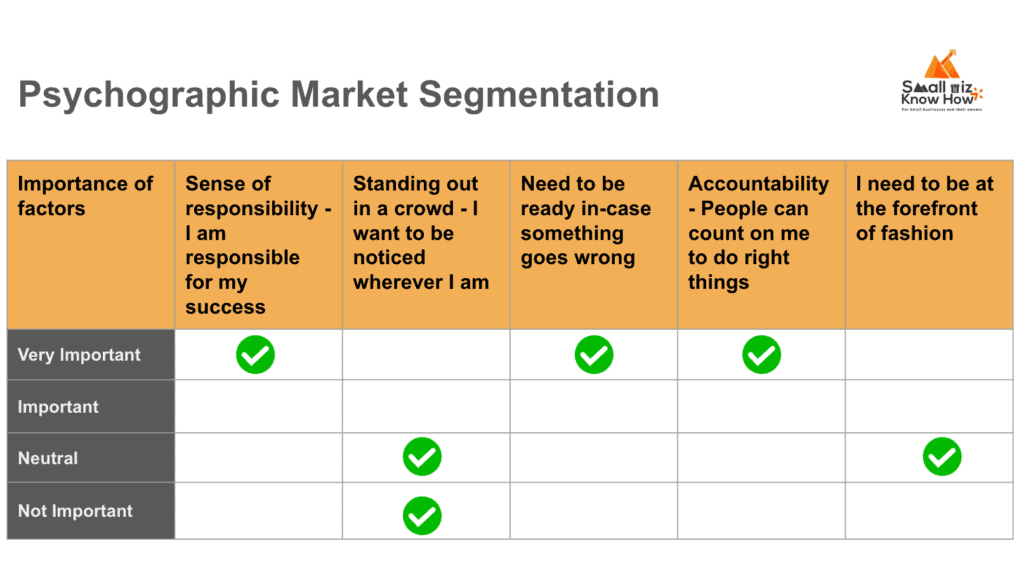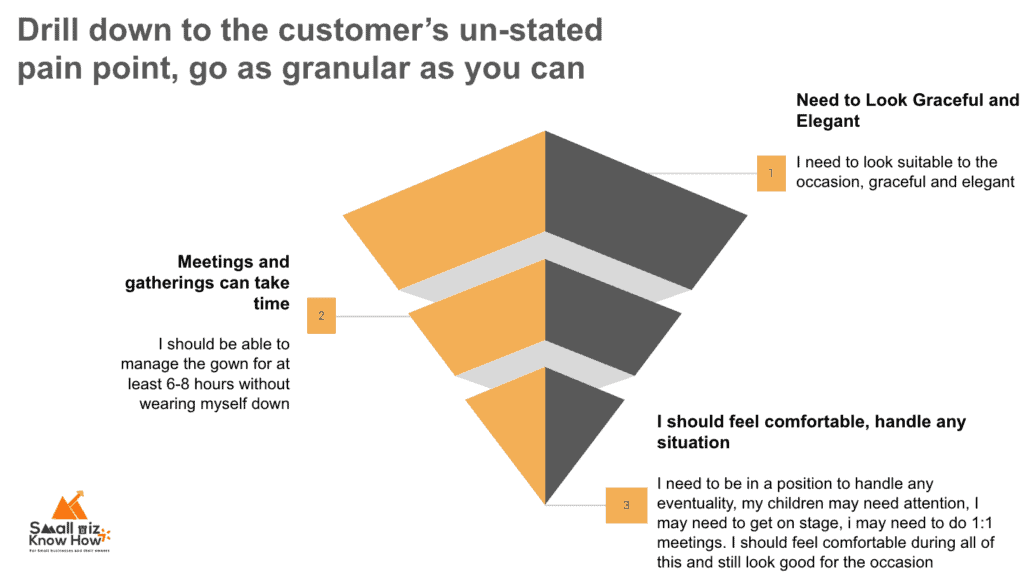Imagine that you are in a room full of potential customers for your product. How will you decide whom to approach first to pitch your product if the audience is extremely diverse? Will you take a random approach and pitch to the person closest to you?
I assume that you will use your judgement and and identify some groups of potential customers whom you would approach first as they may have the highest probability of converting.
Now its going to be a nightmare if you don’t have the slightest clue on whom you will approach first. This is where market segmentation comes into play. Having a structured process of arranging your customers into ‘segments’ so that you know how customers can be organised is what customer segmentation is all about.
Customer segmentation is a critical aspect of a brand building initiative for any small business.
Why is market segmentation important for your small business?

Market segmentation is an often underrated technique that helps a really successful small business stand out in the market. It is what separates the great from the rest. There are some really important reasons why every small business owner must make serious efforts to segment their markets.
- Efficient use of limited resources – This is by far the most important reason from the perspective of a small business. Doing the market segmentation in the right way, will tell you where you must spare your limited resources.
- Targeted communication – By its definition, when you do market segmentation, you will choose some customers and you will reject a few. Your communication needs to only address the customers whom you choose.
- Better product development – Choosing the market segments that you want to serve will help you understand what to prioritise in your product or service. I have detailed out and example from my friends business later in the article.
- Increased Competitiveness – What market segmentation drives is an intense focus on a specific segment of customers. This focus drives innovations and improves competitiveness of the business.
- Improved customer retention – Creating market segments will help your customers choose your for reasons other than just pricing and will drive higher retention since they believe your business suits them better.
As you can see, having a market segmentation strategy for your business can provide strategic advantages for your business. As a business owner you must put yourself in a position to make use of every advantage you can get.
The multiple benefits that market segmentation offers a small business in the go to market strategy
As you saw in the above section, there are many advantages to be gained for a small business by choosing the right market segments. Lets go a bit deeper into the benefits for your business if you have in place the target market segments.
Develop a deep understanding of your customer
- When you choose to segment the market, you gain insights into customer preferences
- This enables you to choose what kind of customers will work for you
- Choosing customers based on their preferences allows you to understand the pain points better
- It becomes easier to do market research since you know who your customer is exactly
Consistent Brand positioning and messaging through your marketing strategy
- You will not end up targeting everyone and thereby no-one if you have a market segmentation activity done
- You can take a stance based on your beliefs since you know who your product is meant for
- Your messages can be very targeted and need not be politically correct, you are not at the risk of offending anyone. You can politely turn away people who get offended since they are not your target segment
- The right market segment allows you to be consistent in the messaging
You build an authority for yourself in your target market
- With an identified target segment, you can double down on targeted content
- This makes you cover the entire ambit of topics related to your target audience
- Covering everything with relevant content for your target audience makes you an authority
- People will start approaching you for your opinion once you have established your business as an authority
It becomes easy to formulate a marketing strategy
- Having the right market segmentation makes the marketing strategy straightforward
- Knowing who your customer is automatically lets you prioritise your marketing channels
- You content and messaging automatically aligns once you know whom your product is for and whom its not for
You can choose the differentiation you want to play
- Knowing the target segment lets you go broad or narrow in your differentiation strategy
- You can choose the nuance and granularity you want to pursue
Make it difficult for competitors to imitate you
- Once you go really deep in your market segmentation exercise, you have an understanding of your customers that no competitor can simply copy
- Your understanding becomes the foundation on which your uniqueness gets built
- You can say NO to many things which your competition cannot say to
Build a moat for your business
- As you start making it difficult for competition to copy what you do, you start building a moat for your business
- Since you understand your customers really well, its unlikely that anyone will want to put in the effort to take that share of customers away from you
- People who copy you will often get stumped after a certain point in time and cannot keep up with your product enhancements since you will know the ‘Why’ behind the decisions
Hope that these benefits are sufficient to push you over the edge to get going and do your target segmentation exercise. Read further to learn how to do it step by step with an example of a friend’s boutique business.
Why small businesses must have a market segmentation strategy right from the beginning?

You are reading this probably at a time where you already have an established business. However, many business owners I know are always trying to do something new. SO i am sure you have a new business idea that is waiting to get implemented.
You must have your market segmentation exercise done before you start your business simply because it will give you an immense amount of clarity on who you are going to serve.
Most businesses I know, have pivoted multiple times in their journey simply because they don’t do a good job at doing a segmentation exercise before building their business model. As a small business, know that you have limited resources. You have to be targeted where you make your spends so that you have the highest probability of success.
The founder of my old employer Intuit, Scott Cook, used to say that a business must really put themselves in the shoes of their customer to understand the customer’s emotions. Scott Cook, used to invite potential customers to his residence to work on ‘Quicken’, the software that helped people file taxes earlier in the day.
He iterated several times before he found the recipe that customers loved and they were willing to pay enough to make the business viable. This paved way for the multi-billion dollar company Intuit that many people know today.
Doing your homework is essential. Being prepared minimises the chance of failure of a small business.
What can your small business do if you don’t have market segments defined but you are already running your business?
Now you might be wondering, great, I am neck deep into my business, I have a ton of things going on currently and I don’t have time to do this market segmentation activity. Perhaps, this is when its even more crucial for you to invest sincere time and effort to doing to this activity.
When you already have run your business for some amount of time, you also have some advantages in the form of ‘hindsight’ that can tell you some of the mis-steps and resource sinks that you should avoid.
You need to have the following things ready from your business to start your market segmentation activity.
Look at customers who pay you well, who make repeat purchases
- Visit them, understand how they live their lives
- Probe deeper into what motivates them generally
- Observe what is of importance to them
- Ask earnestly, why they choose to spend their money on your products
- What will make them go away
- What makes them stick to you
Look at customers who gave you a hard time, haggled for discounts, did not repeat order
- Seek time and visit them to understand their life better
- Observe and infer what is most important to them
- Try and figure out what motivates them
Figure out the marketing communication that worked well with customers who paid you well
- Test some marketing with these customers as you visit them and ask them depper meaning and what connects them to the communication
- Try and figure out the emotion that sticks
Once you have done the above exercise based on the data you have, you are in a good position to lay all of these findings out and think about them patiently. You will figure out nuances in your customer personas.
You will be able to clearly identify what worked for your ‘golden customer’ and what brought in ‘customers that you did not want’. Once you know this, you can follow the step by step process of going about making your target market segments.
How does market segmentation help in improving customer satisfaction by meeting their specific needs?
To quote the Co-founder and CTO of Hubspot, Dharmesh Shah, “Customer Satisfaction = Customer Experience – Customer expectations”
In essence, if you create really high expectations and drop the ball on meeting those expectations, you will have a pretty annoyed customers who might never come back to you.
When you do a good job of market segmentation, you are essentially taking a small portion of the market that you can serve really well. You are signing up for doing your best for a small part of the market.
This keeps you best prepared for delivering a great customer experience.
You cannot deliver a great experience to everyone. Even superman cannot save everyone.
The best part is that the customer that you have chosen to serve, does not really know that you are going to give them a great experience. They come naturally to you because the way you communicate resonates with them.
When you end up delivering a great experience, because you are prepared, the customer is delighted and becomes your advocate.
The first step to doing this is a good market segmentation activity that you do for your business.
Why market segmentation is important to help find a better quality customer for your business?
What do you like better – You working hard to woo a customer, who gives you a hard time, haggles on price and is generally unhappy over everything? or a customer who comes in of their own accord, is willing to pay you what you ask for and is very happy with what you deliver?
I am sure, all business owners will salivate at the second instance.
You can call the second customer as your ‘golden customer’. Now the catch is you have to tailor your business to serve only these customers for your business. You need to leave everyone else out.
In order to do this, the first place you need to start is in building a good market segmentation strategy where you divide your target market into various segments. Once you do that, you have pick whom you will serve.
Once you do this, your marketing strategy will be focused on targeting and communicating only to this audience. Everything about your brand will only communicate with this customer.
This is the only way, you can get the ideal customer to come to your business and be happy with what you offer them. To do this, you should follow all the steps that I have outlined below as an example of a market segmentation activity.
Step by Step process of doing market segmentation as a small business in your market to help amplify your marketing efforts
Lets walk through the market segmentation process together with an example of my friends business. I have detailed out another concept called market ‘market positioning for a small business‘ using her business as an example.
To set the context, my friend runs a boutique business and I am quoting the type of customer she serves so that we can reverse engineer the market segmentation strategy that she could have used.
According to my friend, her ideal target customer is
“A middle aged woman, typically over the age of 35 and under the age of 50. She is a married mother, often to more than one kid. She lives with her family in an upscale neighbourhood. She is well educated, with a college degree, mostly with an advanced degree and holds a position of responsibility in the corporate sector”.

Now, to finalise this type of a granular customer profile, we should first look at all the types of market segmentation that needs to be a part of the market segmentation strategy.
Understanding the types of market segmentation before getting into implementation
Lets look at the types of market segmentation to understand the kind of tools available at our disposal. You need not use everything , but using a combination of more than 3 types is definitely bound to give you a very granular view of who your target customer can be.
- Geographic market segmentation
- Demographic market segmentation
- Psychographic market segmentation
- Behavioural market segmentation (also includes something called Technographic market segmentation)
- Needs based market segmentation
- Value based market segmentation
To define each of these, lets look at them briefly
Geographic Market segmentation – As the name suggests, its basically where your customers are located, are they close to you physically? Are they present in some common online communities/forums even if they are geographically dispersed?
Demographic Market Segmentation – Factors such as age, gender, income, education, income levels are used to identify customer segments.
Psychographic Market segmentation – This is the type of segmentation that has been opened up with the spread of digital marketing. Factors such as preferences, interests, affinity, beliefs and attitudes that are a manifestation of demographics and behavioural traits.
Behavioural Market segmentation – Basically, these are a defined pattern of how your customer would behave in certain situations, the kind of tech-savy-ness they display and preference to one type of device over the other (iphone vs android, desktop vs mobile)
Needs based market segmentation – This looks at the ‘table-stakes’ needs that your customers need from your product or service
Value based market segmentation – The perceived value that the customer gets from using the product or service, the importance that the customer attaches to the value that they receive.
As a small business, always start with geographic market segmentation to decide where your customers are located
Coming back to my friend’s boutique business, she has been very clear from the beginning that she will not look to actively serve customers who are more than a 10 mile radius away from her.

She can choose to expand beyond to even look at customers who may be 25 miles away, but she cannot provide personalised service. Due to commitments in her family, should can’t regularly travel that far, so she would have to hire additional team members to serve those customers.
This can increase her costs and she would need to spend a lot of time training and potentially sacrifice on her interactions with existing customers.
The next step is to focus on Demographic and Psychographic market segmentation since it influences customer behaviour
For my friend’s business, since she has clearly articulated, who her services is for, she has by default excluded a set of customers who do not fit her target profile. Looking at her granular target customer, we can guess that her demographic market segmentation will look like below.

She has specifically chosen to serve women, so gender does not come into the granular focus here. She has consciously chosen to serve slightly older women, who have a decent income which would enable them to buy expensive boutique gowns.
She has also identified that her customers have to be well educated, going so far to say that they need to have a masters degree. The reason she does this is because people who have an advanced degree prioritise a few aspects other than fashion and the need to look ‘sexy’.
Her customers are also usually married mothers or women who aspire to be mothers in the long run. She also prefers to serve women who hold positions of responsibility in the corporate sector or women who are entreprenueurs.

She has then chosen to further narrow down to customers who have a certain set of beliefs and priorities. If you notice how she has selected her customers, you will see that her ideal customers have a strong sense of self worth.
They are intrinsically motivated and hold themselves to high standards. They are responsible and accountable to all their duties, be it at home or at work. They are also ever prepared to handle any crisis.
Looks and surface-level beauty may not be that important to them since that is not what defines them. They are essentially capable women of substance.
What this means is that, women who prioritise fashion, being in the limelight and those who don’t have a sense of responsibility are not her target customers even if they are high income earners.
This is simply because she is able to work well with her target customer since their mental wavelengths match and she is happy to serve them. Her target customers usually love her attitude, work ethic and her ability to prioritise what is important for them.
Move to the ‘Needle-in-the-eye’ pain point of the customer to do a Needs based market segmentation
This is the last step of the segmentation process, where, you take the customers you have identified till now and then go really deep. Identify the pain point that you can solve really well among the customers you have.
Make sure that this pain point is among the most significant pain points your customers have.

In the case of my friend’s boutique business, the biggest pain point for many of her target customers was that, they wanted an exquisite gown, but at the same time, it had to be comfortable and they had to be able to do regular tasks while wearing the gown for a long duration.
My friend’s methods have been honed to solve this pain really well. Her customer’s love her designs and she has almost a 100% repeat purchase rate. She is extremely happy with the limited set of customers she has, since she can do her best work, keep her customers happy and maintain a good lifestyle.
Ultimately, as business owners, the fundamental driving factor for all of us is that we need to be happy doing what we love and we should be able to live a good life doing just that.
